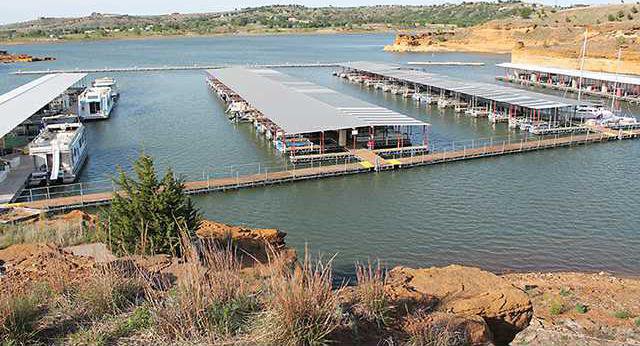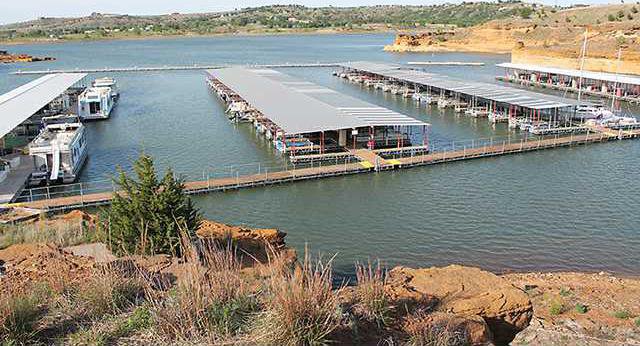Nolan Fisher is the park manager for the Army Corps of Engineers at Wilson Reservoir. Thursday afternoon, he shared with us the good news that the rain event that occurred on Monday, April 25, caused a six-inch rise in the water level at the reservoir. That is the largest that has occurred since May, 2012 when the area began to experience an ongoing drought. The rise brought the level to 10 feet below conservation pool level, compared to the 10.5 feet below that it was just a few weeks earlier.
In the past four years, recreational users of Wilson reservoir have equated the gradually dropping water level with a maintenance project on the dam the Corps has been working on. Many thought in August, 2015, after a four-inch rise following a rain event, the Corps released the water.
An amateur photographer noticed a shop light had been left on in a dam pipe by a worker, and the resulting photograph appeared to show the sun setting over the water on the reservoir side of the dam. Posted on a social media site, the image gave life to the rumor that the Corps was behind the water level at the dam dropping, Fisher said.
“I took a bunch of calls on that one from people who wanted to know what was going on,” he said.
According to Fisher, the Corps project consisted of removing doors from the dam, having them sandblasted and repainted, and then reinstalled. None of this work required a release of water, and the project had no impact on the dam. The blame, he said, falls with Mother Nature.
“We’ve experienced a record low inflow,” he said.
Wilson Reservoir is fed by the Saline River, which since 1946 to present day has had an average flow of 84 cubic feet per second. In the past year, however, that flow has dropped to a mere 7 cfs. The Corps is mandated to release a minimum flow of 5 cfs from the dam, which can’t be deviated from without a formal written request and approval from the Corps.
Local group attempt at decrease denied
Vice President of the Wilson Lake Area Association, Jere Buehler, wrote about his experience working with Senator Jerry Moran and Colonel Sexton from the Kansas City Division Office of the Corps in a recent article in the Great Bend Tribune’s 2016 Lake Wilson Guide. In August 2015, WLAA formally submitted a request asking the core to deviate from the outflow to 2 cfs until the lake level reaches conservation level. The request was denied.
Meanwhile, according to what Buehler learned, evaporation on hot windy summer days can equal or exceed the equivalent of 15 cfs.
This low flow results in a slower fill rate for Wilson than other nearby reservoirs too. Part of the Saline River Basin which is currently very dry, moisture from rain is first absorbed into the ground, which in turn helps to recharge the aquifer, but does little to increase the long-term flow of the river.
Historically slow to fill
The reservoir has never been quick to fill, Fisher said. In fact, when it was built in 1964, some local people worried after two years that it would never fill. It took eight years for it to reach conservation pool level initially. And that, he added, was under normal conditions. This drought, he noted, has been the longest the area has experienced since 1964, so an increase of six inches is to be celebrated.
In regular conditions, the reservoir attracts fishermen and boating enthusiasts from hundreds of miles to what is popularly called the cleanest lake in Kansas. The slow feeding Saline River Basin with its vast grassy areas has the added benefit of cleaning the water before it enters the lake. The result of this downright pokey pace is the mud and sediment filters out before it reaches the lake.
Compare this to the often swift waters of the Smoky Hill River, which churns up mud and sediment in its flow. Cedar Bluffs and Kanopolis who are fed by the Smoky fill faster, but lack the clear water of Wilson. Still, with all but two boat ramps closed due to low water levels, even loyal Wilson boaters have begun exploring the alternatives.
Business finds opportunity
For Terry and Roberta Favinger, owners of the Lake Wilson Marina, the situation required drastic measures to save their business. With their docks sitting in 10 to 14 feet of water, the dropping water levels meant they lost access to all but 50 of their 190 slips.
“We were feeling pretty low,” he said. “But then we came to our senses and realized this was an opportunity we’d been waiting 20 years for.”
Over their two decades of ownership, Terry and Roberta have replaced pretty much all of their docks, he said, but they had to put them all back in the same places when they were done. They’d always wanted to move the docks into deeper water, and now necessity would drive their vision.
First, however, they would need to add a 380-foot break wall to protect the slips which would now be further out in the wind. With that phase of the project completed, he said, the marina is almost completely enclosed. As of the end of April, nearly all the docks had been moved and are sitting in deep water, measuring 15 to 18 feet.
Terry knows he and Roberta are lucky to be able to weather this drought. The dropping lake level has been hard on the local economy. Many “mom and pop” operations like theirs have a feast and famine economic cycle, with much of the annual business being conducted in the summer. The past four years have been especially frustrating, with some vacationers choosing to boat and camp at other nearby reservoirs and lakes.
But, Terry is philosophical at the same time.
“Every lake in Kansas goes through this at some point,” he noted. A few years ago, it was Cheney Reservoir near Wichita that was low, and then it was Kanopolis. The rains come, and the pools fill again.”
Soon, he said, it will be Wilson’s turn again. In the meantime, he’s making the best of the situation, and he hopes his customers will too.





